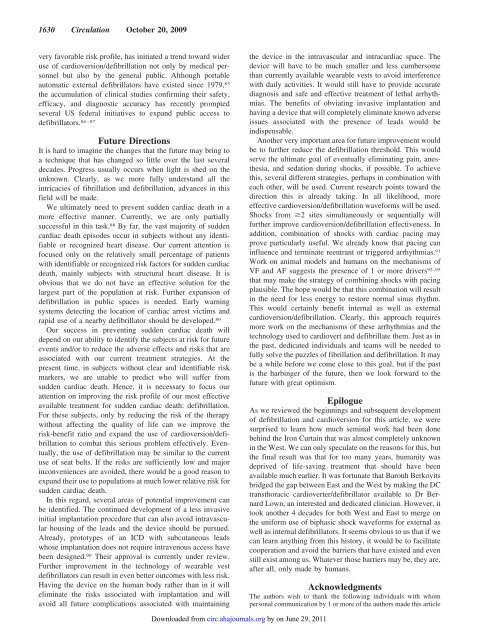Cardioversion Past, Present, and Future - the Laboratory of Igor Efimov
Cardioversion Past, Present, and Future - the Laboratory of Igor Efimov
Cardioversion Past, Present, and Future - the Laboratory of Igor Efimov
Create successful ePaper yourself
Turn your PDF publications into a flip-book with our unique Google optimized e-Paper software.
1630 Circulation October 20, 2009very favorable risk pr<strong>of</strong>ile, has initiated a trend toward wideruse <strong>of</strong> cardioversion/defibrillation not only by medical personnelbut also by <strong>the</strong> general public. Although portableautomatic external defibrillators have existed since 1979, 83<strong>the</strong> accumulation <strong>of</strong> clinical studies confirming <strong>the</strong>ir safety,efficacy, <strong>and</strong> diagnostic accuracy has recently promptedseveral US federal initiatives to exp<strong>and</strong> public access todefibrillators. 84–87 <strong>Future</strong> DirectionsIt is hard to imagine <strong>the</strong> changes that <strong>the</strong> future may bring toa technique that has changed so little over <strong>the</strong> last severaldecades. Progress usually occurs when light is shed on <strong>the</strong>unknown. Clearly, as we more fully underst<strong>and</strong> all <strong>the</strong>intricacies <strong>of</strong> fibrillation <strong>and</strong> defibrillation, advances in thisfield will be made.We ultimately need to prevent sudden cardiac death in amore effective manner. Currently, we are only partiallysuccessful in this task. 88 By far, <strong>the</strong> vast majority <strong>of</strong> suddencardiac death episodes occur in subjects without any identifiableor recognized heart disease. Our current attention isfocused only on <strong>the</strong> relatively small percentage <strong>of</strong> patientswith identifiable or recognized risk factors for sudden cardiacdeath, mainly subjects with structural heart disease. It isobvious that we do not have an effective solution for <strong>the</strong>largest part <strong>of</strong> <strong>the</strong> population at risk. Fur<strong>the</strong>r expansion <strong>of</strong>defibrillation in public spaces is needed. Early warningsystems detecting <strong>the</strong> location <strong>of</strong> cardiac arrest victims <strong>and</strong>rapid use <strong>of</strong> a nearby defibrillator should be developed. 89Our success in preventing sudden cardiac death willdepend on our ability to identify <strong>the</strong> subjects at risk for futureevents <strong>and</strong>/or to reduce <strong>the</strong> adverse effects <strong>and</strong> risks that areassociated with our current treatment strategies. At <strong>the</strong>present time, in subjects without clear <strong>and</strong> identifiable riskmarkers, we are unable to predict who will suffer fromsudden cardiac death. Hence, it is necessary to focus ourattention on improving <strong>the</strong> risk pr<strong>of</strong>ile <strong>of</strong> our most effectiveavailable treatment for sudden cardiac death: defibrillation.For <strong>the</strong>se subjects, only by reducing <strong>the</strong> risk <strong>of</strong> <strong>the</strong> <strong>the</strong>rapywithout affecting <strong>the</strong> quality <strong>of</strong> life can we improve <strong>the</strong>risk-benefit ratio <strong>and</strong> exp<strong>and</strong> <strong>the</strong> use <strong>of</strong> cardioversion/defibrillationto combat this serious problem effectively. Eventually,<strong>the</strong> use <strong>of</strong> defibrillation may be similar to <strong>the</strong> currentuse <strong>of</strong> seat belts. If <strong>the</strong> risks are sufficiently low <strong>and</strong> majorinconveniences are avoided, <strong>the</strong>re would be a good reason toexp<strong>and</strong> <strong>the</strong>ir use to populations at much lower relative risk forsudden cardiac death.In this regard, several areas <strong>of</strong> potential improvement canbe identified. The continued development <strong>of</strong> a less invasiveinitial implantation procedure that can also avoid intravascularhousing <strong>of</strong> <strong>the</strong> leads <strong>and</strong> <strong>the</strong> device should be pursued.Already, prototypes <strong>of</strong> an ICD with subcutaneous leadswhose implantation does not require intravenous access havebeen designed. 90 Their approval is currently under review.Fur<strong>the</strong>r improvement in <strong>the</strong> technology <strong>of</strong> wearable vestdefibrillators can result in even better outcomes with less risk.Having <strong>the</strong> device on <strong>the</strong> human body ra<strong>the</strong>r than in it willeliminate <strong>the</strong> risks associated with implantation <strong>and</strong> willavoid all future complications associated with maintaining<strong>the</strong> device in <strong>the</strong> intravascular <strong>and</strong> intracardiac space. Thedevice will have to be much smaller <strong>and</strong> less cumbersomethan currently available wearable vests to avoid interferencewith daily activities. It would still have to provide accuratediagnosis <strong>and</strong> safe <strong>and</strong> effective treatment <strong>of</strong> lethal arrhythmias.The benefits <strong>of</strong> obviating invasive implantation <strong>and</strong>having a device that will completely eliminate known adverseissues associated with <strong>the</strong> presence <strong>of</strong> leads would beindispensable.Ano<strong>the</strong>r very important area for future improvement wouldbe to fur<strong>the</strong>r reduce <strong>the</strong> defibrillation threshold. This wouldserve <strong>the</strong> ultimate goal <strong>of</strong> eventually eliminating pain, anes<strong>the</strong>sia,<strong>and</strong> sedation during shocks, if possible. To achievethis, several different strategies, perhaps in combination wi<strong>the</strong>ach o<strong>the</strong>r, will be used. Current research points toward <strong>the</strong>direction this is already taking. In all likelihood, moreeffective cardioversion/defibrillation waveforms will be used.Shocks from 2 sites simultaneously or sequentially willfur<strong>the</strong>r improve cardioversion/defibrillation effectiveness. Inaddition, combination <strong>of</strong> shocks with cardiac pacing mayprove particularly useful. We already know that pacing caninfluence <strong>and</strong> terminate reentrant or triggered arrhythmias. 91Work on animal models <strong>and</strong> humans on <strong>the</strong> mechanisms <strong>of</strong>VF <strong>and</strong> AF suggests <strong>the</strong> presence <strong>of</strong> 1 or more drivers 92–95that may make <strong>the</strong> strategy <strong>of</strong> combining shocks with pacingplausible. The hope would be that this combination will resultin <strong>the</strong> need for less energy to restore normal sinus rhythm.This would certainly benefit internal as well as externalcardioversion/defibrillation. Clearly, this approach requiresmore work on <strong>the</strong> mechanisms <strong>of</strong> <strong>the</strong>se arrhythmias <strong>and</strong> <strong>the</strong>technology used to cardiovert <strong>and</strong> defibrillate <strong>the</strong>m. Just as in<strong>the</strong> past, dedicated individuals <strong>and</strong> teams will be needed t<strong>of</strong>ully solve <strong>the</strong> puzzles <strong>of</strong> fibrillation <strong>and</strong> defibrillation. It maybe a while before we come close to this goal, but if <strong>the</strong> pastis <strong>the</strong> harbinger <strong>of</strong> <strong>the</strong> future, <strong>the</strong>n we look forward to <strong>the</strong>future with great optimism.EpilogueAs we reviewed <strong>the</strong> beginnings <strong>and</strong> subsequent development<strong>of</strong> defibrillation <strong>and</strong> cardioversion for this article, we weresurprised to learn how much seminal work had been donebehind <strong>the</strong> Iron Curtain that was almost completely unknownin <strong>the</strong> West. We can only speculate on <strong>the</strong> reasons for this, but<strong>the</strong> final result was that for too many years, humanity wasdeprived <strong>of</strong> life-saving treatment that should have beenavailable much earlier. It was fortunate that Barouh Berkovitsbridged <strong>the</strong> gap between East <strong>and</strong> <strong>the</strong> West by making <strong>the</strong> DCtransthoracic cardioverter/defibrillator available to Dr BernardLown, an interested <strong>and</strong> dedicated clinician. However, ittook ano<strong>the</strong>r 4 decades for both West <strong>and</strong> East to merge on<strong>the</strong> uniform use <strong>of</strong> biphasic shock waveforms for external aswell as internal defibrillators. It seems obvious to us that if wecan learn anything from this history, it would be to facilitatecooperation <strong>and</strong> avoid <strong>the</strong> barriers that have existed <strong>and</strong> evenstill exist among us. Whatever those barriers may be, <strong>the</strong>y are,after all, only made by humans.AcknowledgmentsThe authors wish to thank <strong>the</strong> following individuals with whompersonal communication by 1 or more <strong>of</strong> <strong>the</strong> authors made this articleDownloaded from circ.ahajournals.org by on June 29, 2011



